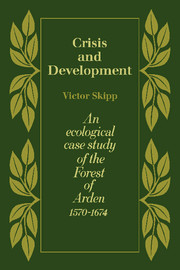Crossref Citations
This Book has been
cited by the following publications. This list is generated based on data provided by Crossref.
McGUIRE, RANDALL
and
NETTING, ROBERT McC.
1982.
Leveling peasants? the maintenance of equality in a Swiss Alpine community.
American Ethnologist,
Vol. 9,
Issue. 2,
p.
269.
Kussmaul, Ann
1985.
Agrarian Change in Seventeenth-Century England: The Economic Historian as Paleontologist.
The Journal of Economic History,
Vol. 45,
Issue. 1,
p.
1.
Lawson, Peter
1986.
Property Crime and Hard Times in England, 1559-1624.
Law and History Review,
Vol. 4,
Issue. 1,
p.
95.
Bruland, Kristine
1988.
“The Coming of Industrial Order.” A Review Article.
Comparative Studies in Society and History,
Vol. 30,
Issue. 2,
p.
388.
Hoppit, Julian
1988.
Income, Welfare and the Industrial Revolution in Britain.
The Historical Journal,
Vol. 31,
Issue. 3,
p.
721.
Goldstone, Jack A.
1988.
Regional Ecology and Agrarian Development in England and France.
Politics & Society,
Vol. 16,
Issue. 2-3,
p.
287.
Goldstone, Jack A.
1988.
East and West in the Seventeenth Century: Political Crises in Stuart England, Ottoman Turkey, and Ming China.
Comparative Studies in Society and History,
Vol. 30,
Issue. 1,
p.
103.
Yelling, J.
1990.
Historical Geography of England and Wales.
p.
181.
Chase, Malcolm
1992.
Can History be Green? A Prognosis.
Rural History,
Vol. 3,
Issue. 2,
p.
243.
DeWindt, Anne Reiber
1995.
Witchcraft and Conflicting Visions of the Ideal Village Community.
The Journal of British Studies,
Vol. 34,
Issue. 4,
p.
427.
Hindle, Steve
2002.
The State and Social Change in Early Modern England, 1550–1640.
p.
37.
Wood, Andy
2002.
Riot, Rebellion and Popular Politics in Early Modern England.
p.
82.
Turner, Michael
Beckett, John
and
Afton, Bethanie
2003.
Agricultural Sustainability and Open-Field Farming in England, c.1650–1830.
International Journal of Agricultural Sustainability,
Vol. 1,
Issue. 2,
p.
124.
Neeson, Jeanette M.
2003.
Les propriétés collectives face aux attaques libérales (1750-1914).
p.
39.
Baker, Alan R. H.
and
Billinge, Mark
2004.
Geographies of England.
2004.
As You Like It.
p.
223.
Brooke, John
2006.
A Companion to Colonial America.
p.
44.
Grove, Richard
and
Damodaran, Vinita
2009.
Nature's End.
p.
23.
2009.
Law, Politics and Society in Early Modern England.
p.
307.
2009.
As You Like It.
p.
194.





